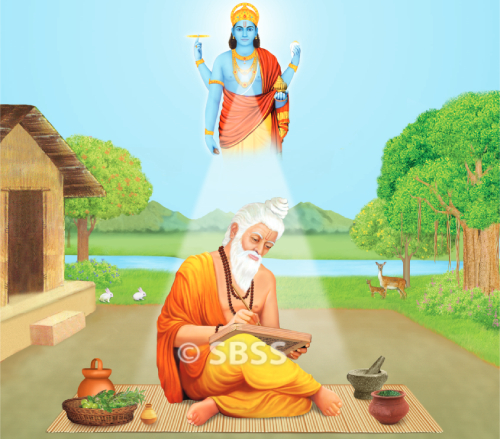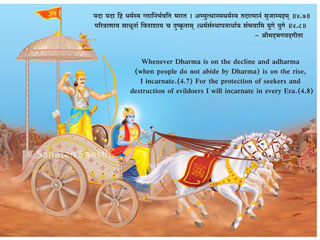Ayurveda for a healthy life ! – 19/2024

Diseases are classified as per environmental factor, genetic, nutrition, major and minor diseases, region of the body affected, as per doshas, pathogenesis, and as per defence mechanism. A part was discussed in issue 18/2023 where in A. Diseases of body and mind B. Nija and Agantu diseases C. Ekadoshaja, Dwandwaja and Sannipatika diseases – were discussed. Now it is continued as given below.
D. Sushruta’s classification
तत्तु सप्तविधे व्याधावुपनिपतति । ते पुनः सप्तविधा व्याधयः तद्यथा आदिबलप्रवृत्ताः जन्मबलप्रवृत्ताः दोषबलप्रवृत्ताः संघातबलप्रवृत्ताः
कालबलप्रवृत्ताः दैवबलप्रवृत्ताः स्वभावबलप्रवृत्ता इति ।। – सु. सू. २४.४
1. Adibala pravrutta or sahaja diseases that is hereditary
diseases : These diseases arise due to defective chromosomes or genes transmitted from father or mother.
2. Janmabala pravrutta or garbhaja disease that is congenital diseases : These diseases are caused by chromosomal or genetic anomalies. In addition, various factors operating on the foetus in the intrauterine life also lead to congenital diseases, example indiscretion in diet or activity of mother, effects of drugs taken by mother, disease in mother etc.
3. Doshabala-pravrutta or jataja diseases that is diseases caused by doshas.
Disturbances in vata, pitta and kapha takes place as a result of indiscretion in diet and activity, which can affect both body
as well as mind. They are further classified as diseases due to increased dosha or decreased dosha.
4. Sanghata-bala-pravrutta or peeda-kruta that is traumatic diseases. These traumatic diseases can be classified further as physical trauma example injuries, accidents, operations etc. and mental trauma example sudden unexpected bad news, sudden loss of money etc.
5. Kala-bala-pravrutta or kalaja diseases that is diseases due to environmental factors –
कालबलप्रवृत्ता ये शीतोष्णवातवर्षाप्रभृतिनिमित्ताः ।
तेऽपि द्विविधाः व्यापन्न-ऋतकृता अव्यापन्न-ऋतुकृताश्च ।। – सु. सू. २४.७
The various environmental factors like heat, cold and exposure to rain also lead to diseases. They can be further classified as :
5A. Diseases due to seasonal changes that is Avyapanna-rutu- kruta and,
5B. Diseases due to sudden unexpected changes in the environment that is Vyapanna-rutu-kruta.
6. Daiva : Bala pravrutta or prabhavaja diseases that is diseases arising due to bad luck or misfortune
These diseases arise, when one insults teachers, parents, respected people or God or due to one’s bad deeds either in
this or past lives. They also can arise as a result of affection by supernatural powers like ghosts or curses of sages.
7. Swabhava-bala-pravrutta that is natural disease :
स्वभावबलप्रवृत्ताः क्षुत्पिपासाजरामृत्युनिद्राप्रभृतयः ।
तेऽपि द्विविधाः कालकृता अकालकृताश्च ।
तत्र परिरक्षणकृता अकालकृताः । – सु. सू. २४.७
These are hunger, sleep, thirst, old age and death. They are also further classified as.
7A . Kala-kruta or timely diseases that is when they occur at the expected time.
7B . Akala-kruta or Untimely diseases that is when they occur unexpectedly
E. Diseases of tissues, associated tissues and waste products :
Diseases are also classified as –
Diseases of dhatu that is tissues, upadhatu that is associated tissues and mala that is waste products.
F. Diseases according to the state of nutrition
1. Santarpanottha diseases that is diseases due to over nutrition example obesity, diabetes.
Eating oily, fatty, sweet and heavy food items like meat of aquatic animals, jaggery, starch in excess, sleeping during the day and leading an inactive life leads to over-nutrition and various diseases associated with it. These diseases are obesity, diabetes, diabetic skin lesions, skin disorders of kaphaja type, itching, anaemia, fever, diseases associated with aama, dysuria, laziness, drowsiness, heaviness, feeling as if kapha is sticking to various body channels and sense and motor organs, giddiness, worry and oedema.
2. Apatarpanottha vyadhi that is diseases due to under-nutrition example emaciation, tuberculosis.
Taking dry, light and inadequate quantity of food, fasting and excessive exertion lead to diseases associated with under-nutrition. Under-nutrition leads to loss of weight and strength, weak digestive power, wasting of all the tissues, loss of lustre of the skin, fever with cough, pleural effusion, loss of taste sensation, impaired hearing, delirium, insanity, heart disease, constipation, oliguria, pain in the thighs, sacrum and joints and all varieties of vataja diseases.
G. Prakruti-sama-samavaya and Vikruti-vishama-samavaya
Diseases caused by two or more doshas that is dwandvaja or sannipatika are classified into prakruti-sama-samavaya and vikruti-vishama-samavaya.
In prakruti-sama-samavya type, the manifestations of increased doshas are encountered as expected. In vikruti-vishama-samavaya apart from the expected manifestations, one also gets unexpected manifestations. This may be explained on assumption that prakruti-sama-samavaya represents the simultaneous affection of two or more doshas, where as the vikruti-vishama-samavaya represents chemical combination of two or more doshas.
H. Major and Minor diseases
Mahagada that is major diseases are difficult to cure, tend to become chronic or produce unbearable pain or are associated with high mortality.
1. Vatavyadhi that is diseases of nervous system,
2. Apasmara that is epilepsy,
3. Major skin diseases,
4. Prameha and Madhumeha that is metabolic disorders with characteristic urinary abnormality and diabetes mellitus,
5. Udara, that is enlargement of abdomen due to ascites.
6. Shotha that is generalised anasarca,
7. Rajayakshma that is tuberculosis,
8. Gulma that is tumour arising as a result of weakness of wall of an organ,
9. Ashmari that is calculi example renal or gall stones.
10. Bhagandara that is fistula in anus.
11. Arsha that is piles.
12. Grahani that is malabsorption syndrome and
13. Moodhagarbha that is abnormal presentation of foetus.
These major diseases are often associated with some complication like lack of vitality, emaciation, hiccup, breathlessness, thirst, vomiting, fever fainting, diarrhoea, etc.
I. Disease according to region (System) of the body affected
According to the region of the body affected, diseases are classified as peripheral diseases, diseases of middle zone and diseases of digestive tract.
1. Diseases of peripheral structures : These are classified as –
A. Skin diseases.
B. Disorders of body fluid.
C. Blood disorders.
2. Diseases of middle zone : These are classified as –
A. Diseases of nervous system.
B. Diseases of genito-urinary system.
C. Cardio-vascular diseases.
D. Respiratory diseases.
E. Musculo-skeletal diseases.
3. Diseases of the digestive tract : It includes diseases of gastro-intestinal tract, liver, spleen and pancreas.
J. Anubandhya – Anubandhi doshas and diseases
A disease may arise as a result of simultaneous increase of one, two or all the three doshas. These are termed as Kewala, Dwandwaja or Tridoshaja disease example when cough starts due to simultaneous increase in both pitta and kapha, it is termed as Pitta-kaphaja-kasa. When cough starts due to marked increase in pitta and slight increase in kapha, it is termed as Sakapha-pittaja kasa. When cough due to increased kapha that is kaphaja kasa is followed by increased pitta and aggravates the original disease, it is termed as pittanubandhikaphaja kasa.
K. Pachanatmaka, Shodhanatmaka & Prachayatmaka diseases
Some authors classify the diseases according to their pathogenesis.
In any disease the doshas accumulate, increase, spread, get localized in a particular organ and lead to manifestations of diseases after damaging the organ. The body tries to decrease the doshas by 1. digestion of the doshas that is Pachana, 2. by getting rid of doshas from the body that is shodhana and, 3. by localisation and accumulation of doshas in one part of the body (Prachayatmaka).
According to the dominant defence mechanism of the body, the diseases are classified as pachanatmaka, shodhanatmaka & prachayatmaka.
Pachanatmaka diseases : Fever, abscesses and all infections and inflammatory diseases represent pachanatmaka diseases. In these diseases, body tries to neutralise and decrease the accumulated doshas by their digestion through tissue enzymes.
Shodhanatmaka diseases : Diseases like vomiting, cold, cough etc. in which the body tries to get rid off doshas through natural passages are termed as shodhanatmaka diseases. In these diseases, one should not try to suppress the natural passage of toxins in early stages of the disease.
Prachayatmaka diseases : If the rate of accumulation of doshas exceeds that of digestion or removal of the doshas, the result is prachayatmaka disease. Various tumors, enlargement of glands, hypertrophy of various organs, obesity, hepato-splenomegaly, etc. are some of the examples of prachayatmaka diseases.
These diseases usually manifest slowly and the symptoms manifest late. The patient gets gradually adapted to the slowly accumulating doshas. By promoting local accumulation of doshas, body tries to prevent dissemination and damage to other organs.
Thus diseases can be classified in many ways. The above mentioned classification gives clue to understanding the various aspects of diseases.

 Take Disciplinary Action Against Charitable Hospitals Violating Rules : Surajya Abhiyan
Take Disciplinary Action Against Charitable Hospitals Violating Rules : Surajya Abhiyan Detergent found in ice-creams, phosphoric acid in soft drinks !
Detergent found in ice-creams, phosphoric acid in soft drinks ! Radiant Thoughts of Sachchidananda Parabrahman (Dr) Jayant Athavale
Radiant Thoughts of Sachchidananda Parabrahman (Dr) Jayant Athavale Law banning Conversion of Religion is against Individual Freedom : Babbles Former Judge S Muralidhar
Law banning Conversion of Religion is against Individual Freedom : Babbles Former Judge S Muralidhar Editorial : Khalistan, Balochistan and Pakistan
Editorial : Khalistan, Balochistan and Pakistan After India becomes a ‘Hindu Rashtra’, Russia will embrace Hinduism and spread it globally : Nostradamus’ Prophecy
After India becomes a ‘Hindu Rashtra’, Russia will embrace Hinduism and spread it globally : Nostradamus’ Prophecy